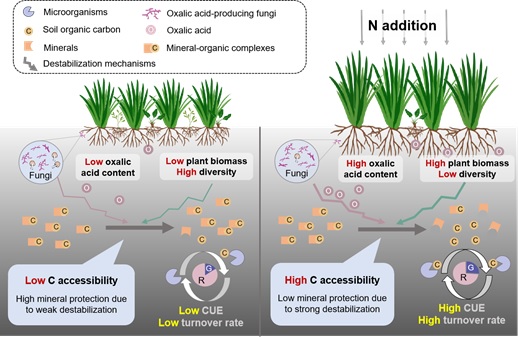Anthropogenic nitrogen (N) input to terrestrial ecosystems has nearly doubled during the past decades, which would substantially alter the structure and function of terrestrial ecosystem. As a critical microbial physiological parameter, microbial carbon use efficiency (CUE), calculated as the ratio of C used for biomass production to total C uptake by microbes, largely controls the fate of soil C under the increasing N input. Therefore, clarifying the response of microbial CUE to N enrichment and the relevant mechanism is imperative for us to have an accurate understanding of soil C dynamics.
A research group led by Prof. YANG Yuanhe from the Institute of Botany of Chinese Academy of Sciences elucidated a new mechanism underlying the responses of microbial CUE to N input.
The study has been published in Global Change Biology recently.
The researchers combined a multi-level field N addition experiment for 6 years with a substrate-independent  labelling approach, as well as high-throughput sequencing and mineral analysis.
labelling approach, as well as high-throughput sequencing and mineral analysis.
They observed that N addition would increase microbial CUE primarily by promoting microbial growth. However, in contrast to the prevailing view, they found that the elevated microbial growth and CUE were not mainly driven by the reduced stoichiometric imbalance, but strongly associated with the increased soil C accessibility from weakened mineral protection.
Moreover, the researchers demonstrated that such attenuated organo–mineral association was further linked to the N-induced changes in the plant community and the increased oxalic acid in the soil.
This study revealed the regulatory mechanisms underlying the microbial CUE response to N addition by integrating plant, geochemical and microbial controls simultaneously, and further provided empirical evidence for the tight linkage between mineral-associated C dynamics and microbial physiology.
“Therefore, Earth System Models should fully consider the shifts in the complex plant–microbe–mineral interactions to better project the dynamics of microbial CUE and soil C under increased anthropogenic N input,” said CHEN Leiyi, one of the correspondence authors.

Schematic diagram showing the pathways regulating the responses of microbial C metabolism to increasing anthropogenic nitrogen (N) input (Image from IBCAS).
Article Link: https://doi.org/10.1111/gcb.16229
Contact:
CHEN Leiyi Chen and Yang Yuanhe
Institute of Botany, Institute of Botany, the Chinese Academy of Sciences
Email: chenly@ibcas.ac.cn; yhyang@ibcas.ac.cn
Anthropogenic nitrogen (N) input to terrestrial ecosystems has nearly doubled during the past decades, which would substantially alter the structure and function of terrestrial ecosystem. As a critical microbial physiological parameter, microbial carbon use efficiency (CUE), calculated as the ratio of C used for biomass production to total C uptake by microbes, largely controls the fate of soil C under the increasing N input. Therefore, clarifying the response of microbial CUE to N enrichment and the relevant mechanism is imperative for us to have an accurate understanding of soil C dynamics.
A research group led by Prof. YANG Yuanhe from the Institute of Botany of Chinese Academy of Sciences elucidated a new mechanism underlying the responses of microbial CUE to N input.
The study has been published in Global Change Biology recently.
The researchers combined a multi-level field N addition experiment for 6 years with a substrate-independent ![]() labelling approach, as well as high-throughput sequencing and mineral analysis.
labelling approach, as well as high-throughput sequencing and mineral analysis.
They observed that N addition would increase microbial CUE primarily by promoting microbial growth. However, in contrast to the prevailing view, they found that the elevated microbial growth and CUE were not mainly driven by the reduced stoichiometric imbalance, but strongly associated with the increased soil C accessibility from weakened mineral protection.
Moreover, the researchers demonstrated that such attenuated organo–mineral association was further linked to the N-induced changes in the plant community and the increased oxalic acid in the soil.
This study revealed the regulatory mechanisms underlying the microbial CUE response to N addition by integrating plant, geochemical and microbial controls simultaneously, and further provided empirical evidence for the tight linkage between mineral-associated C dynamics and microbial physiology.
“Therefore, Earth System Models should fully consider the shifts in the complex plant–microbe–mineral interactions to better project the dynamics of microbial CUE and soil C under increased anthropogenic N input,” said CHEN Leiyi, one of the correspondence authors.

Schematic diagram showing the pathways regulating the responses of microbial C metabolism to increasing anthropogenic nitrogen (N) input (Image from IBCAS).
Article Link: https://doi.org/10.1111/gcb.16229
Contact:
CHEN Leiyi Chen and Yang Yuanhe
Institute of Botany, Institute of Botany, the Chinese Academy of Sciences
Email: chenly@ibcas.ac.cn; yhyang@ibcas.ac.cn
